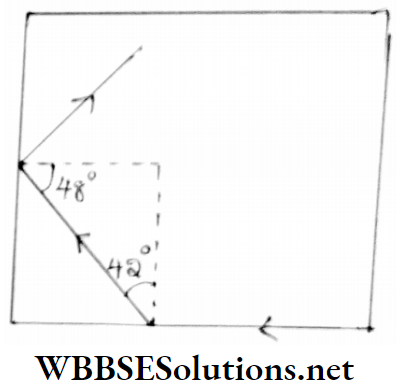Optics
Refraction Of Light Long Questions and Answers
Question 1. Monochromatic rays of light coming from a vacuum are refracted in a medium of refractive index μ. Show that the ratio of the wavelength of the incident ray and that of the refracted ray is equal to the refractive index of the medium.
Answer:
Suppose the wavelength of light in a vacuum is λ and its velocity is c. The corresponding values in a medium of refractive index μ are λ’ and c’. The frequency of light is v . The frequency of light remains the same in all media. So the velocity of light in vacuum, c = vλ and velocity of flight in the referred medium c’ = vλ’
Now refractive index of the medium,
= \(\frac{\text { velocity of light in vacuum }}{\text { velocity of light in the medium }}=\frac{c}{c^{\prime}}\)
= \(\frac{\nu \lambda}{\nu \lambda^{\prime}}=\frac{\lambda}{\lambda^{\prime}}\)
Question 2. Can the value of the absolute refractive index of a medium be less than 1?
Answer:
The absolute refractive index of a medium is the ratio of the velocity of light in a vacuum to the velocity of light in that j medium. Since the velocity of light in vacuum is greater than that in any other medium, the value of the absolute refractive index of a medium cannot be less than 1.
Question 3. A beam of converging rays of light meets at a point on a screen. A parallel plane glass slab is kept in the path of the converging rays. How far will the intersecting point of the rays be shifted? Draw a diagram to show it
If a parallel plane glass slab is placed on the path of the beam of converging rays, the intersecting point of the rays will be shifted away from the previous point. We know that a ray of light incident obliquely on a parallel glass slab emerges with a lateral displacement. In the path of the rays has been drawn and the displacement of the intersecting point has been shown. In the absence of a glass slab, the rays PQ, XY and RS would meet at 0. But due to the presence of the glass slab, the rays meet at O’. Hence, the displacement of the intersecting point = OO’
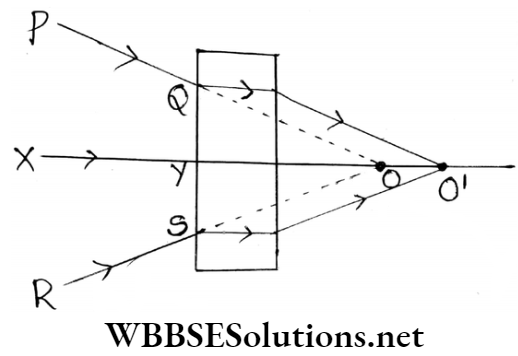
Question 4. A ray of light is refracted from medium 1 to medium 2. Show that the ratio of the sine of the angle of incidence and the sine of the angle of refraction is equal to the ratio of the speed of light in medium 1 and that in medium 2.
Answer:
If the absolute refractive indices of medium 1 and We know, medium 2 are //j and p2 respectively we know
⇒ \(\frac{\sin i}{\sin r}={ }_1 \mu_2=\frac{\mu_2}{\mu_1}\) ……………….(1)
Now \(\mu_1=\frac{c}{v_1}\) [c = speed of light in vacuum, = speed of light in medium]
⇒ \(\mu_2=\frac{c}{v_2}\) [v2= Speed of light in medium 2]
⇒ \(\frac{\mu_2}{\mu_1}=\frac{\frac{c}{v_2}}{\frac{c}{v_1}}\)
= \(\frac{v_1}{v_2}\) ……………. (2)
From (1) and (2) we get,
⇒ \(\frac{\sin i}{\sin r}=\frac{v_1}{v_2}\)
Question 5. μ1 are μ2 the refractive indices of a medium for two electromagnetic waves. If μ1 is greater than /2, then which wave will move faster than the other?
Answer:
Let c1 and c2 be the velocities of the two electromagnetic waves in the given medium
μ1 = \(\frac{c}{c_1}\)
μ2= \(\frac{c}{c_2}\)
c = velocity of an electromagnetic wave in vaccum]
⇒ \(\frac{\mu_1}{\mu_2}=\frac{\frac{c}{c_1}}{\frac{c}{c_2}}\)
⇒ \( \frac{c_2}{c_1}\)
Now since μ1 > μ2, therefore c1 >c2
So the second wave moves faster through the medium.
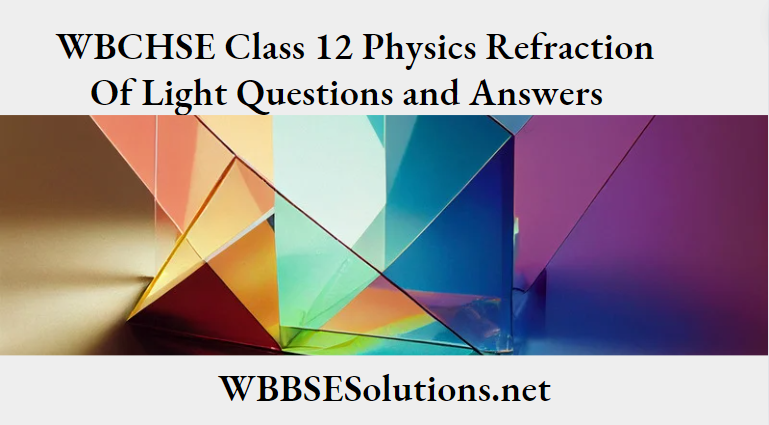
Question 6. An object is placed at a certain depth from the upper surface of a liquid. When it is seen from the air, it appears that the object is raised through \(\frac{1}{3}\) of the depth. Again if water is taken instead of the liquid it appears that the object is raised above through \(\frac{1}{4}\) of the real depth. The refractive index of liquid = \(\frac{3}{2}\) and refractive index of water| = \(\frac{4}{3}\) Explain the matter
Answer:
Suppose that the real depth of the object below the surface of the liquid is d and the apparent depth is d.
The refractive index of the liquid μ1= 1.5
We know, μ1 = \(\frac{\text { real depth }}{\text { apparent dept }}\)
Or, \(\frac{3}{2}=\frac{d}{d}\) Or, d ‘= \(\frac{2}{3}\) d
∴ The apparent change in depth
= d-d’ = d –\(\frac{2}{3}\) = \(\frac{1}{3}\)d
= Apparent upward displacement of the object.
Again refractive index of water,μw = \(\frac{4}{3}\)
So in the case of water,
μw = –\(\frac{d}{d^{\prime}}=\frac{4}{3}\)
Or, d’ = –\(\frac{3}{4}\)
The apparent change in depth
= d-d’ = d – \(\frac{3}{4}\) d
= \(\frac{1}{4} d\)
= apparent upward displacement of the object
Question 7. What sort of arrangement is to be taken so that an object cannot be visible even in light? Or, why is a piece of glass immersed In glycerine not visible?
Answer: An object having nearly the same refractive index as to be same. But if the rod is the medium will not be visible in that medium. Since the refractive indices of both of them are nearly the same, reflection or refraction of visible rays almost does not take place at their surface of separation and light will travel almost undefeated through them.
Then it cannot be understood that light is travelling from one medium to another. It seems as if light is moving in die same medium. As a result, the surface of separation is not visible. So a medium vanishes in the other medium
The refractive indices of glycerine and glass are almost equal. So when a piece of glass is immersed in glycerine kept in a vessel, the piece of glass is not visible
Question 8. There is a branch hanging from a tree on the bank of a lake. It is at a height of h1 from the surface of the water. A diver underwater sees it at a height of h2. What Is the relation between h1 and h2 Given, μw
Answer:
As the object is situated in a rarer medium and it is seen from the denser medium, the apparent height of the object
= \(\frac{\text { from the surface of water }}{\text { real height of the object }}=\frac{h_2}{h_1}\)
Or, 1.33 \(=\frac{h_2}{h_1}\) Or, 1.33 h1
Question 9. A red ray and a violet ray passing through a glass slab Fig 2.72 ly c arc incident simultaneously on an interface with air. It is seen that the red ray is refracted but the violet ray is reflected. Explain the reason behind it.
Answer:
The refractive index of glass for red light is smaller than that of glass for violet light. Since the critical angle, θc = sin \(\sin ^{-1} \frac{1}{\mu}\), the critical angle of glass for red light is comparatively greater. So the angle at which the red and the violet rays are incident is smaller than the critical angle of red light but greater than the critical angle of violet light. So the red light is refracted and the violet light is reflected
Question 10. A rod immersed horizontally in water does not appear small when viewed normally but appears small if It is kept vertically. Explain. What sort of arrangement is to be taken so that an object cannot be visible even in light? Or, why is a piece of glass immersed In glycerine not
Answer:
When the rod is kept horizontally underwater, every point of the rod appears to be upward equally due to refraction.
So, the length of the rod appears immersed vertically, and different points of the rod appear to be and form an image. Since its depth, is apparent dis upward with different distances displacement of a point depends placement of the lower point of the rod is larger than the higher point. Thus, the apparent displacement of the lowest and highest points of the rod are maximum and minimum respectively. So, the rod appears to be small
Question 11. The critical angle of glass and air is 42’. If a ray of light Is incident normally on the face of an equilateral prism, show that the ray will emerge from the base of the prism normally. Calculate the deviation of the ray.
Answer:
ABC is an equilateral prism. Each angle of the prism is 60°. A ray of light PQ is incident normally on the face AB. Without changing direction it travels along QR and Is incident at R on the face of AC
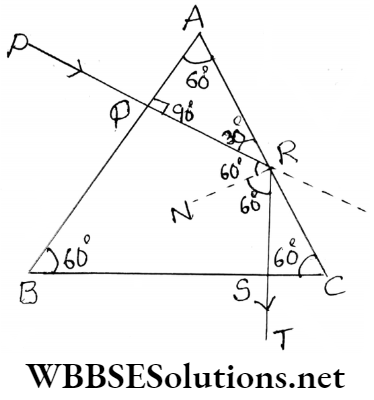
According to the ∠ARQ = 30°
The angle of incidence at R = 60°
We know that the critical angle of glass and air Is 42°.
So the ray incident at R will be reflected and will follow the path RST.
∠NRS = 00°
Again ∠ACB = 60°
So, ∠CRS = 30°
So, ∠CSR = 90°
So the ray RST will emerge along the normal to the face BC. The angle of deviation of the ray = 180°- (60° + 60°) = 60°
12. A beam of light consisting of red, green and blue colours Is incident on the right-angled prism. The refractive Indices of the material of the prism for red, green and blue lights are 1.39, 1.44 and 1.47 respectively. Will the prism separate the colours?
Answer:
Let the critical angles for red, green and blue lights be θr,θg, and θb respectively.
So, sin θr = \(\frac{1}{1.39}\) Or, sin θr = 0.719 Or, θr=, 46
Again, sin θg = \(\frac{1}{1.44}\) Or, sin θg = 0.694 Or, θr=, 44
And sin θb = \(\frac{1}{1.47}\) Or, sinθb = 0.680 Or, =, 42.9
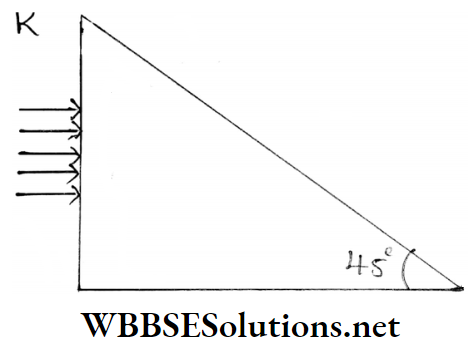
According to, the rays are incidentally on the first face and are refracted without deviation. So the rays of all the colours are incident on the second face at an angle of incidence 45°. The green and blue rays are incident on the second face at angles greater than their respective critical angles. So these two rays are reflected from the second face and after reflection emerge from the base of the prism perpendicularly.
So the rays of these two colours will not be separated. The ray of red colour is incident on the second face of the prism at an angle less than the critical angle. So it will emerge from the face after refraction through it. Therefore, only the red light becomes separated from the incoming beam of light
Question 13. A ray of light is Incident on medium A If the emergent ray through medium C is parallel to the ray incident on medium A, then find the refractive index of medium C
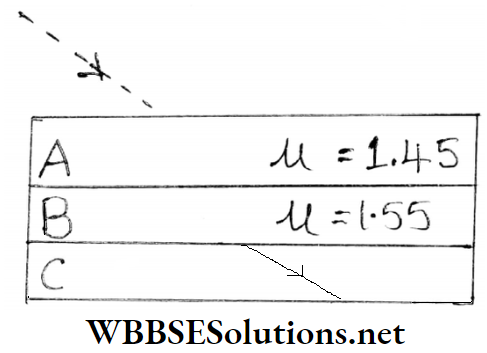
Answer:
As the incident ray and the final emergent ray are Parsi to each other, the two rays are in the same medium. So, the active index of the medium C is the same as that of air
14. The phenomenon of refraction is associated with the change in the velocity of light. When a ray of light is incident normally on a glass slab, a change in the velocity of light takes place. Then state why there is no change in the direction of light
Answer:
Suppose, v and v’ are the velocities of tight in vacuum and glass medium respectively. According to Snell’s law,
⇒ \(\frac{\sin i}{\sin r}=\frac{v}{v^{\prime}}\)
⇒ \(\sin r=\frac{v^{\prime}}{\nu} \sin i\)
For normal incidence, i = 0
sin i = 0
∴ sin r = 0 or, r = 0
So, for normal incidence though the change in velocity takes place, there is no change in direction—since both the angle of incidence and the angle of refraction are zero.
Question 15. A ray is incident at a small angle θ on a glass slab of thickness t. If the refractive index of glass is μ, show that the lateral displacement of the emergent ray from 45°/ the slab is t θ (μ-1)/μ.
Answer:
The lateral displacement of the emergent ray BD relative to the incident ray AO is BC
⇒ \(O B \cdot \frac{B C}{O B}=O P \cdot \frac{O B}{O P} \cdot \frac{B C}{O B}\)
= OP sec ∠BOP. sin ∠BOC
= t sec θ’ sin(θ – θ’ )
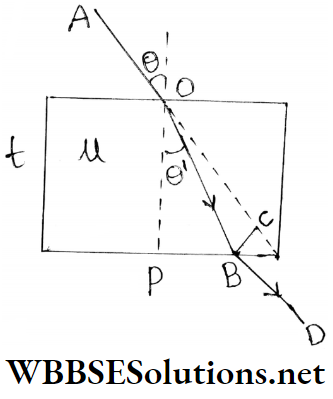
θ and θ’ being small we have
sec θ’ = \(\frac{1}{\cos \theta^{\prime}} \approx \frac{1}{1}\) = 1
sin( θ- θ’)≈θ- θ’
Bc= t(θ- θ’)= \(t \theta\left(1-\frac{\theta^{\prime}}{\theta}\right)\)
Again, \(\mu=\frac{\sin \theta}{\sin \theta^{\prime}} \approx \frac{\theta}{\theta^{\prime}}\)
Or, \(\frac{1}{\mu}=\frac{\theta^{\prime}}{\theta}\)
∴ Lateral displacement
BC = tθ \(\left(1-\frac{1}{\mu}\right)=t \theta \frac{(\mu-1)}{\mu}\)
Question 16. When a rectangular glass slab is placed on different coloured letters, the violet-coloured letter appears to be raised more. What is the reason behind it?
⇒ \(x=t\left(1-\frac{1}{\mu}\right)\)
Or, \((t-x)=\frac{t}{\mu}\)
Where t = thickness of the slab and u – refractive index for the particular colour of light.
Since Mv for violet colour is maximum, the value of (f-x) i.e., the distance of the letter from the top of the slab will be minimum, thus the letters of violet colour will seem to be raised more than other colours
17. For a few minutes before sunrise and a few minutes after sunset we can see the sun explain with proper reason
Answer:
As the height above the earth’s surface increases, the density of air decreases. Any ray coming obliquely from near the horizon gradually enters denser layers from rarer layers of air. So due to refraction, the ray bends towards the ground. This incident happens when the sun is below the horizon just after sunset and just before sunrise. If we see along the direction of the rays reaching us, the sun appears raised in position in the sky above the horizon
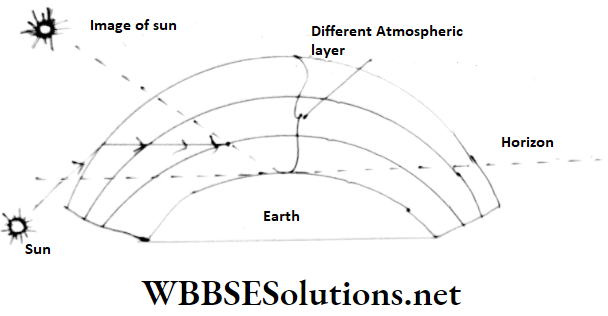
Question 18. A ray of light passing through the medium of refractive index μ1 is incident on the surface of separation of another medium of refractive index μ2. A part of the ray is reflected and another part is refracted. What should be the angle of incidence so that the reflected ray and the refracted ray are at right angles to each other?
Answer:
According to
i+ 90°+r = 180°
Or, r = 90°- i-r
By Snells law
μ1 sin i= μ2 sir r
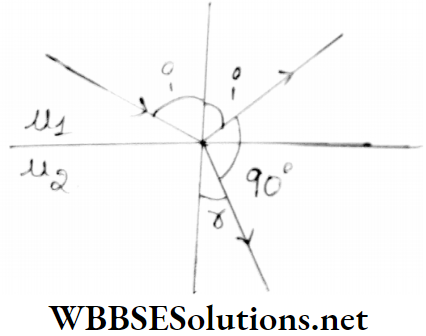
∴ \(\frac{\sin i}{\sin \left(90^{\circ}-i\right)}=\frac{\mu_2}{\mu_1}\)
Or, \(\frac{\sin i}{\cos i}=\frac{\mu_2}{\mu_1}\)
Or, \(\tan i=\frac{\mu_2}{\mu_1}\)
i = \(\tan ^{-1}\left(\frac{\mu_2}{\mu_1}\right)\)
Question 19. A ray of light passes through a glass slab of thickness t and refractive index μ If the velocity of light in vacuum c is then how much time will the light take to emerge from the slab?
Answer:
Velocity of light in the glass
v = \(\frac{c}{\mu}\)
∴ To overcome the glass slab of thickness t, time is taken by light
⇒ \(\frac{t}{v}=\frac{t}{\frac{c}{\mu}}\)
⇒ \(\frac{\mu t}{c}\)
Question 20. A bird is moving towards the water surface perpendicularly downwards. To a fish in the water just below the bird, where will the bird appear to be in comparison to its actual position?
Answer:
We know that if the object is in a rarer medium and the observer is in the denser medium then the refractive index of the denser medium,
μ = \(\frac{\text { apparent height of the object }}{\text { real height of the object }}\)
Here, \(\mu_w=\frac{\text { apparent height of bird }(x)}{\text { real height of bird }(d)}\)
x= μw × d
μw >1
∴ x>d
Therefore to the fish, the bird appears to be slightly higher than its actual position
Question 21. For a beam of light emerging from the glass into the air, for which visible spectral colour the critical angle of glass will be minimal?
Answer:
The wavelength of violet rays is the least among all the visible spectral colours. If wavelength decreases, the refractive index increases. Again when the refractive index increases, the critical angle decreases. Therefore,’ during refraction from glass to air the critical angle will be minimum for the violet-ray
Question 22. For the same angle of incidence, the angles of refraction for, Three different media A, H and C are 15°, 25° and 35° respectively. In which is the velocity of light minimum?
Answer:
The absolute refractive Index of a medium Is given by
= \(\frac{\sin i}{\sin r}=\frac{c}{v}\)
v = \(c \frac{\sin r}{\sin i}\)
Here, i = Angle of incidence,
r = Angle of refraction
c- Velocity of light in vacuum (constant)
v = Velocity of light In the required medium.
So, for the same angle of incidence i, v ∝ sin r. Therefore v mill is the minimum for the medium where slur i.e., r will be the minimum.
In this case, since the angle of refraction r is minimum In a medium A, the velocity of light is minimum in this medium.
Question 23. A glass prism is Immersed In winter. What change will take place In the value of the angle of minimum deviation? Answer: If the refractive indices of the material of the prism in air and water are aub and respectively. Then we can write,
⇒ \(a^{\mu_g}=\frac{\sin \frac{A+\delta_m}{2}}{\sin \frac{A}{2}}\)
⇒ \(w^{\mu_g}=\frac{\sin \frac{A+\delta_m^{\prime}}{2}}{\sin \frac{A}{2}}\)
Since wμg< aμg
Therefore δg< δg‘
That is The angle of minimum deviation decreases due to immersion of the prism in water.
Question 24. A ray of light is incident on the face of a triangular glass prism and is reflected. What conclusion will you draw regarding the value of the refractive index of the glass prism?
Answer:
According to the ray of light is incident at a gle of 45° on the’ hypotenuse face and is reflected, I.e., in o. glass
The critical angle of gliosis concerning air-less
For the same angle of incidence the angles of refraction for than 45μ
We, know \(i_c=\sin ^{-1} \frac{1}{f}\)
⇒ \(\sin ^{-1} \frac{1}{11}<45^{\circ}\)
Or, \(\frac{1}{\mu}<\sin 15^{\circ}\)
Or, \(\frac{1}{\mu}<\sin 45^{\circ}\)
Or, \(\mu>\frac{1}{\sin 45^{\circ}} \quad \text { or, } \mu>\sqrt{2}\)
= 1.414
So, the value of the refractive index of glass will be higher than 1.414
Question 25. On placing a transparent glass cube page of a hook, it was found that the covered printed words are not visible from any of the lateral sides of the [WI3CHSE Sample Question] on the printed cube. Explain why? Answer: The refractive index of glass relative to air, (i = 1.5. So, the critical angle for the two media,
Answer:
The refractive index of glass relative to air, (i = 1.5)
So, the critical angle for the two media
= \(\sin ^{-1}\left(\frac{1}{\mu}\right)=\sin ^{-1}\left(\frac{1}{1.5}\right)\)
= 42° (nearly)
There is always a thin layer of air between the glass cube and the paper. If any ray from the printed words is incident on the lower surface of the cube even with the maximum angle of 90°, then it enters the glass with a maximum angle of refraction of 42°.
Then, the minimum angle of incidence of the ray on the side face of the cube becomes'(90°- 42°) or 48°. A total internal reflection occurs as this angle is greater than the critical angle, and no ray can emerge out of the side face.
